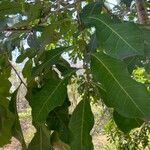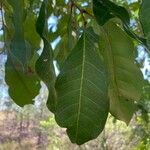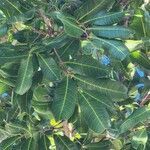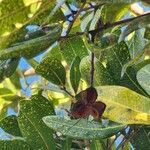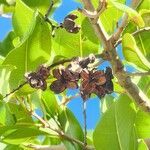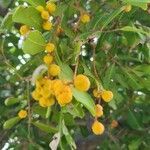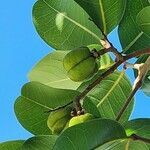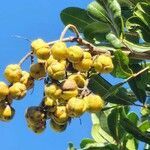Trees, treelets or shrubs, (0.5-)2.5-20 m high, dbh up to 45 cm, usually much and widely branched; trunk fluted; bark green or grey to brown, smooth to finely rough, inner bark pink to brown-ish; wood white to (pinkish) brown, heartwood visually darker. Flowering twigs l-4(-5) mm in diam., striate, rarely grooved, strigose, glabrescent. Leaves (l-)2-6(-7)-jugate; petiole l-6(—10.5) cm long, flattened above, rounded below, towards the apex terete, strigose; rachis 0.5-16.5 cm long, flattened above, rounded below, at least towards the apex, striate, often grooved above, strigose, glabrescent; petiolules (0.5-)l-6(-13) mm, grooved above, shortly appressed-hairy (to almost glabrous). Leaflets opposite to alternate, (narrowly) obovate, rarely elliptic, symmetric to slightly asymmetric, upper (1.5-)5-16(-19) by 0.5-7.5 cm, index 1.2-3.8(-4.2), above dull or glossy, light to dark green, below paler so, sometimes greyish, (thinly) coriaceous, above glabrous, below glabrous to thinly shortly appressed-hairy, midrib usually a bit more densely so; base (broad-)cuneate, rarely rounded; apex obtuse to rounded, rarely shortly and broadly acuminate, often retuse, rarely emarginate; margin entire; midrib above rarely slightly prominent, or slightly sunken, nerves (5-)7-16(-20) per side, (2-)5-15(-22) mm apart, angle to midrib 50-70°. Inflorescences axillary to pseudoterminal, often pendulous, 2-36 cm long, with (very) long, rarely short branches, rarely unbranched, laxly flowered; cymules dichasial, 1-several-flowered; bracts and bracteoles lanceolate to deltoid, sometimes semi-orbicular, 0.4-1 by 0.4-1.1 mm, not persisting, outside shortly appressed-hairy, margin short cibate and rarely also with short glandular hairs, in-side glabrous; pedicels 1.3-6 mm long, articulated at the base or up to halfway. Flower buds more or less globular, 1.8-4.2 by 2-4.8 mm. Sepals persisting, irregularly dentate, outside shortly appressed-hairy except rim, margin ciliolate and with glandular hairs, inside glabrous, outer elliptic to almost orbicular, sometimes triangular, 0.8-3.8 by 0.8-4.2 mm, scarious rim narrow, inner more or less orbicular, 1.8-5.6 by 2.4-6 mm, scarious rim wide. Petals white, elliptic to broad-ovate (or semi-orbicular), 0.5-3.7 by 0.6-3.6 mm, with some ap-pressed hairs in basal part or glabrous on both surfaces; scales 2, not crested, 0.5-1.7 mm high, long-ciliate. Disc green, glabrous or with few hairs to 5 tufts of hairs. Stamens 8, rarely 6 or 7, exserted; filaments pale pink, 1.2-4.2 mm long, patently hairy in lower half; anthers yellow, 1.2-2.9 mm long, glabrous or hairy; in female flowers filaments 1.3-3.6 mm long, anthers 1.2-3 mm long. Ovary 3-celled, shortly appressed-hairy, style 0.8-3.3 mm long; stigma 0.4-1.3 mm long, 3-lined; pistillode shortly appressed-hairy, sometimes also with longer hairs, 0.7-1.8 by 0.6-1.4 mm. Fruits green or yellow to orange brown, obpyramidal to ellipsoid, obscurely 3-lobed, 3-keeled or-ribbed at least when young, 9-20 by 10-21(-29) mm, stipe l-2(-4) mm; wall 0.6-2.2 mm thick, outside almost smooth to rugose, velutinous, inside villose to appressed hairy. Seeds flattened ellipsoid, 5-14 by 4-9 mm, testa shiny black; arillode red, covering half to whole of the seed (sometimes oblique), lacerate or grossly dentate to lobed at apex, cotyledons unequal or equal, (obliquely) superposed, rarely (Gulliver 32) collateral.
More
Tree to 15 m high. Branchlets and leaf axes shortly appressed pubescent to glabrous, lenticellate. Leaf rachis 2.5–13.5 cm long; leaflets 4–8, occasionally to 12; lamina obovate or elliptic, obtuse to retuse, entire, obtuse to acute at base, 4.5–19 cm long, 1.5–7.5 cm wide, glabrous or lower surface puberulous, coriaceous; lateral veins 6–20 mm apart; reticulation prominent; petiolule 2–7 mm long; petiole 3–7.5 cm long. Panicles 8–35 cm long, peduncles pubescent; cymules stalked; pedicels 3–7 mm long. Calyx lobes 2.5–4 mm long, puberulent or glabrous. Petals ovate, 1.5–3 mm long; scales short. Fruit shortly stipitate, subglobose, apiculate, slightly carinate at sutures, 1.5–3 cm long, 1.5–2.2 cm diam., puberulent, golden-yellow, red-tinged; valves thick, villous inside. Aril yellow to orange-red.
An evergreen tree. It grows 8-15 m high. It can spread 5-15 m across. It has a dense rounded crown. The trunk is smooth and pale grey. The inner bark is orange. The leaves have leaflets along the stalk. The leaves are 10-20 cm long with 2-6 pairs of opposite leaflets. The leaflets are leathery and dark green. They are oblong with a rounded tip. They are 7-10 cm long by 3-5 cm wide. The flowers are greenish-white. The fruit occur in long chains. They are orange. They are leathery and have 3-6 lobes. They are 1-2 cm across. The seeds are black. They have a reddish attachment.
